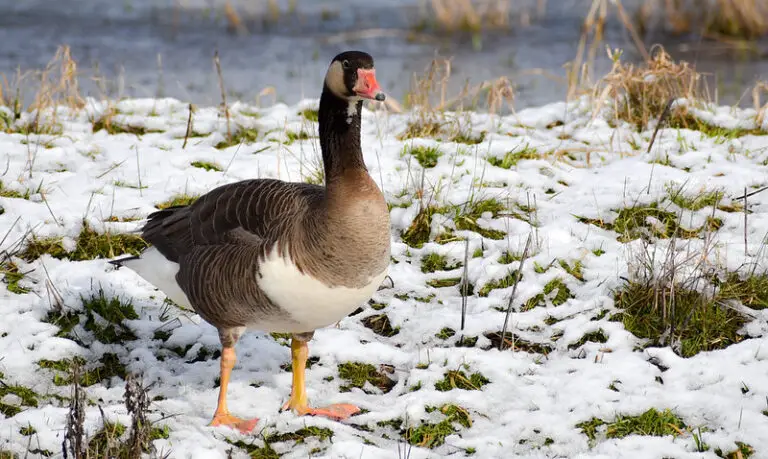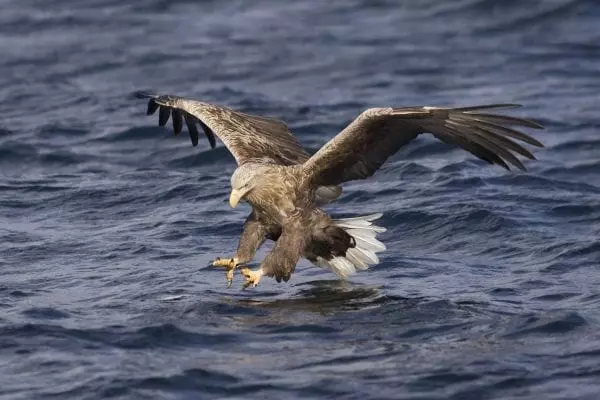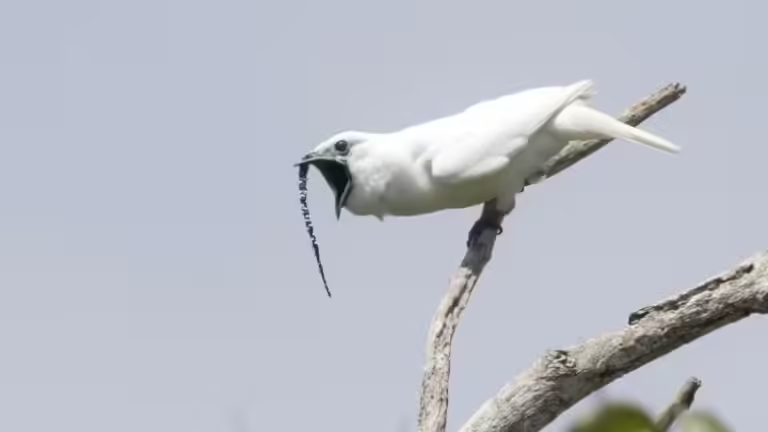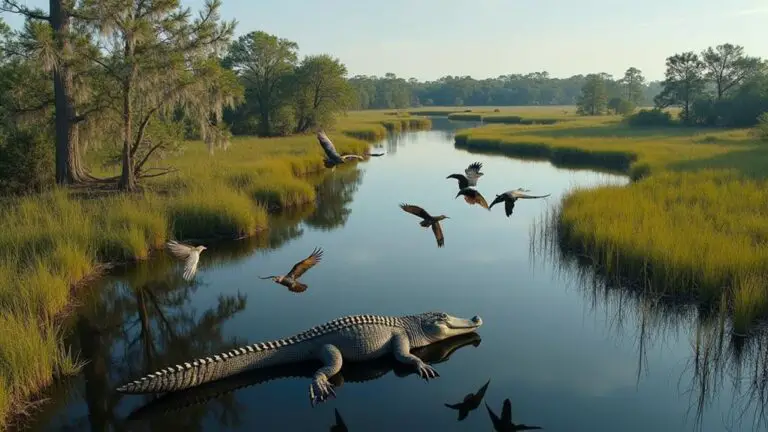Welcome to our guide to hawks in South Carolina. If you are a bird enthusiast or simply interested in learning about the magnificent hawks that reside in this state, you are in the right place. This article will provide you with valuable insights into the various species of hawks found in South Carolina, their habitats and behaviors, migration patterns, conservation challenges and efforts, bird watching hotspots, and much more.
Key Takeaways
- South Carolina is home to a diverse range of hawk species with unique characteristics.
- Identifying hawks in South Carolina requires knowledge of physical features and behavior patterns.
- Hawks in South Carolina prefer specific habitats and have distinct hunting and nesting habits.
- Observing hawk migration in South Carolina is best done at certain times and locations.
- Conservation efforts aimed at protecting hawk populations and their habitats are ongoing in South Carolina.
- Joining guided hawk watching tours is a great way to observe and learn more about these birds.
- Individuals can take practical actions to protect hawks and their habitats in South Carolina.
- Hawks in South Carolina play an important ecological role in maintaining the balance of the local ecosystem.
- Hawks feature prominently in the culture and art of South Carolina.
The Diversity of Hawks in South Carolina
If you’re interested in bird watching, South Carolina is a great place to be. There are many species of hawks that call the state home, each with its own unique characteristics and habitats.
The Red-Tailed Hawk
The red-tailed hawk is one of the most commonly spotted hawks in South Carolina. The rusty-red tails and broad wings of these birds, which frequently have a distinctive dark band near the tips, make them simple to identify. Red-tailed hawks can be found throughout the state, but are most commonly seen soaring over open fields and forested areas.
The Cooper’s Hawk
The Cooper’s hawk is a medium-sized bird with a slate-gray back and wings, and a rusty-brown barred chest. These hawks can often be found hunting in woodland areas, where they pursue small mammals and birds through the trees. Cooper’s hawks are sometimes seen in urban areas, where they hunt small birds around bird feeders and other sources of food.
The Sharp-Shinned Hawk
The sharp-shinned hawk is a small, agile bird with short, rounded wings and a long tail. These hawks are often compared to falcons due to their speedy flight and hunting tactics. Sharp-shinned hawks can be found in wooded areas throughout South Carolina, where they hunt small birds and mammals from perches and in flight.
These are just a few examples of the many hawks that can be found in South Carolina. Keep an eye out for these birds on your next bird watching excursion and see if you can spot any of their unique characteristics!
Identifying Hawks in South Carolina
Identifying different hawk species in South Carolina can often be challenging, but with a few tips and techniques, you can learn to tell them apart.
Firstly, pay attention to their physical features. Hawks in South Carolina vary in size, shape, and coloration, but there are certain characteristics that are common among different species. For example, the Red-tailed Hawk has a distinct red tail that can be seen when it is in flight or perched. The Cooper’s Hawk has a rounded tail and a head that appears large in proportion to its body. The Broad-winged Hawk is smaller than both the Red-tailed and Cooper’s Hawks and has broad wings that appear rounded at the tips.
Another way to identify hawk species is to observe their behavior. Hawks have distinctive hunting patterns and flight styles that can be used for identification. For example, the Sharp-shinned Hawk has a quick, agile flight and is often seen darting through trees in pursuit of prey. The Red-shouldered Hawk has a slower, more methodical flight and is often seen perched near bodies of water.
It’s also important to pay attention to the habitat in which the hawk is found. Different species of hawks prefer different habitats, such as forests, grasslands, or wetlands. By observing the location and environment in which you spot a hawk, you can narrow down the possible species.
Overall, identifying hawks in South Carolina takes practice and patience, but with these tips and techniques, you can become an expert at distinguishing different species.
Habitats and Behavior of South Carolina Hawks
South Carolina’s diverse landscapes provide ideal habitats for a variety of hawk species. From the coastal plains to the mountainous regions, hawks can be found nesting, perching, and hunting in various habitats.
Red-tailed hawks are commonly found in open country areas, perching on telephone poles and trees as they survey the surroundings for prey. Cooper’s hawks, on the other hand, prefer the cover of dense forests, where they can hunt smaller birds and mammals.
| Hawk Species | Preferred Habitat |
|---|---|
| Red-tailed Hawk | Open country areas |
| Broad-winged Hawk | Forested areas near water |
| Cooper’s Hawk | Dense forests |
| Sharp-shinned Hawk | Forested areas, especially near bird feeders |
Hawks are considered to be at the top of the food chain and are known for their hunting prowess. They use a combination of speed, agility, and sharp talons to capture prey, including small mammals, birds, and reptiles. Many hawk species are also known for their aerial acrobatics, using soaring and gliding techniques to conserve energy while they search for prey.
Hawks are known to be monogamous, with pairs often forming strong bonds that can last for years. They typically mate and nest in the same area each year, with some species even returning to the same nest. Hawks can be protective of their nests and young, and will vigorously defend their territory if threatened.
Despite their impressive hunting abilities, hawks are not immune to threats. Habitat loss due to urban development and deforestation, pollution, and illegal hunting are all significant challenges facing hawk populations. Understanding their habitats and behaviors is crucial to protecting these magnificent birds.
Hawk Migration in South Carolina
South Carolina is a prime location for observing hawk migration. Each year, thousands of hawks travel through the state as they make their way to their wintering grounds in Central and South America. The peak of hawk migration in South Carolina typically occurs from mid-September to early November.
Some of the best places to witness this incredible spectacle include Caesar’s Head State Park, Paris Mountain State Park, and Sassafras Mountain. These locations offer unobstructed views of the sky and are located along the Appalachian Mountains, a natural avenue for bird migration.
What Hawks Can You Expect to See?
During the migration season, you may encounter a variety of hawk species in South Carolina. These include:
| Hawk Species | Description |
|---|---|
| Sharp-shinned Hawk | A small hawk with distinctive dark bars on its wings and a squared-off tail. |
| Cooper’s Hawk | A medium-sized hawk with a rounded tail and a dark cap on its head. |
| Red-tailed Hawk | A large hawk with a reddish-brown tail and a distinctive dark band at the end. |
| Red-shouldered Hawk | A medium-sized hawk with reddish-brown underparts and distinctive black-and-white bands on its wings. |
Other species that may be spotted during migration include Broad-winged Hawks, Northern Harriers, and Ospreys.
When is the Best Time to Observe Hawk Migration in South Carolina?
The best time to observe hawk migration in South Carolina is between mid-September and early November. During this time, hawks are making their way south for the winter and are more likely to fly during the day to take advantage of thermals that help them conserve energy.
Weather conditions can also impact hawk migration, with clear, sunny days offering the best viewing opportunities. On days with strong winds or rain, hawks may be less likely to migrate.
Visiting a hawk watch site during the late morning or early afternoon is recommended, as this is when hawks are typically most active.
Threats to South Carolina Hawks
Unfortunately, many hawk populations in South Carolina are facing a range of threats that jeopardize their survival. Some of the most significant issues include:
| Threat | Impact |
|---|---|
| Habitat loss and fragmentation | Reduced availability of suitable nesting and hunting areas |
| Pollution | Contaminated food sources and exposure to toxins |
| Illegal hunting and trapping | Direct mortality and disturbance |
| Climate change | Altered migration patterns and habitat suitability |
These threats have serious consequences for hawk populations and the broader ecosystem. Habitat loss and fragmentation are particularly concerning, as they can decrease genetic diversity and disrupt natural ecological processes.
It is essential to address these challenges and take steps to protect South Carolina’s hawk populations. This requires a collaborative effort from individuals, organizations, and government agencies to develop and implement effective conservation strategies.
Protecting Hawks in South Carolina
You can play a crucial role in protecting hawks and their habitats in South Carolina. Here are some actions you can take:
- Support conservation organizations and initiatives that work to protect hawks and their habitats
- Advocate for policies that promote sustainable land use and mitigate the effects of climate change
- Reduce your use of pesticides and encourage others to do the same
- Report any illegal hunting, trapping, or habitat destruction to local authorities
- Participate in citizen science projects to monitor hawk populations and document their behavior
By taking these actions and raising awareness of the threats facing hawks in South Carolina, you can help ensure that these magnificent birds continue to thrive in the wild.
South Carolina Hawk Conservation Efforts
If you’re concerned about the well-being of hawks in South Carolina, you’ll be happy to know that there are many ongoing efforts and initiatives aimed at protecting and conserving their populations.
One such project is the Hawk Watch Program, which monitors and tracks hawk populations during their migratory seasons. The South Carolina Department of Natural Resources oversees this program, which relies on citizen scientists to gather information and report their findings.
South Carolina Bird Conservation Initiative
Another important conservation effort in South Carolina is the South Carolina Bird Conservation Initiative (SCBCI). This program was established in 2004 as a partnership between government agencies, conservation organizations, and academic institutions.
The SCBCI focuses on preserving and restoring habitats for endangered bird species, including hawks, and works to educate the public about the importance of bird conservation. They conduct research, provide funding for conservation projects, and advocate for policies that protect bird populations and their habitats.
South Carolina Audubon Society
The South Carolina Audubon Society is another organization that plays a significant role in conservation efforts for hawks and other bird species. They offer educational programs, organize birding events, and advocate for policies that protect birds and their habitats.
The Society also partners with other groups to conduct research and conservation projects, and they manage several bird sanctuaries throughout the state.
By supporting these and other conservation efforts, you can help ensure that hawks and other bird species continue to thrive in South Carolina for generations to come.
Bird Watching Hotspots in South Carolina
If you are looking for the perfect spots to observe hawks in South Carolina, you are in luck. With its diverse habitats and rich wildlife, the state offers numerous locations where you can enjoy birdwatching and catch a glimpse of various hawk species. Here are some of the top bird watching hotspots in South Carolina:
| Name | Location | Hawk Species |
|---|---|---|
| Cape Romain National Wildlife Refuge | Charleston County | Red-tailed, Red-shouldered, Cooper’s, and Broad-winged Hawks |
| Table Rock State Park | Pickens County | Red-tailed, Red-shouldered, and Cooper’s Hawks |
| Hunting Island State Park | Beaufort County | Red-tailed, Red-shouldered, Cooper’s, and Broad-winged Hawks |
| Francis Beidler Forest | Dorchester County | Red-tailed, Red-shouldered, Cooper’s, and Broad-winged Hawks |
| Angel Oak Park | Charleston County | Red-tailed, Red-shouldered, Cooper’s, and Broad-winged Hawks |
Each of these locations offers a unique experience, whether you are a seasoned birdwatcher or a beginner. Some of the parks offer guided tours or have observation platforms that allow you to view hawks from a safe distance. Others are more isolated, providing an opportunity to observe the birds in their natural habitats.
Additional Tips for Bird Watching in South Carolina
When planning your bird watching trip, it is important to be prepared. Here are some additional tips to help you make the most of your hawk watching experience in South Carolina:
- Dress for the weather and wear comfortable shoes.
- Bring binoculars and a field guide to help identify different hawk species.
- Pack snacks and water, especially if you plan to hike or spend several hours at the park.
- Respect the wildlife and their habitats. Do not disturb nesting birds or approach them too closely.
- Stay on designated trails and follow park regulations.
By following these simple guidelines, you can enjoy a safe and fulfilling bird watching experience in South Carolina. Whether you are looking to expand your knowledge of local wildlife or simply enjoy the beauty of nature, observing hawks in their natural habitats is an experience you won’t forget.
Joining South Carolina Hawk Watching Tours
If you’re interested in getting up close and personal with South Carolina’s hawks, joining a guided hawk watching tour can be a fantastic way to learn more about these fascinating birds and observe them in their natural habitats.
There are various tour companies that offer hawk watching excursions throughout the state, with experienced guides who can share their knowledge and expertise. Some popular locations for these tours include Congaree National Park, the Francis Marion National Forest, and the Santee Coastal Reserve.
During these tours, you’ll have the opportunity to see a range of hawk species, including the Red-tailed Hawk, Cooper’s Hawk, and Sharp-shinned Hawk, among others. Your guide will also explain the different behaviors and identifying features of each species, helping you to further your knowledge of these magnificent birds.
In addition to observing hawks, many tours also offer the chance to see other wildlife, including eagles, owls, and various songbirds. Some tours may also provide binoculars and spotting scopes, making it easier to get a closer look at the birds.
Whether you’re a seasoned birdwatcher or just starting out, joining a South Carolina hawk watching tour can be an unforgettable experience. So why not book a tour today and see these incredible birds in action?
Protecting Hawks and Their Habitats in Your Area
As a lover of wildlife and nature, you can make a significant impact on the protection and conservation of hawks and their habitats in South Carolina. Here are some practical tips and actions that you can take:
- Support conservation organizations: There are numerous organizations dedicated to wildlife conservation in South Carolina. Consider donating your time or money to support their efforts to protect and conserve hawks and their habitats.
- Manage your property: If you own property in South Carolina, consider implementing wildlife-friendly practices like planting native plants, reducing pesticide use, and leaving dead trees for nesting and roosting sites.
- Report violations: If you witness any illegal hunting, trapping, or disturbance of hawk nests, report it to the South Carolina Department of Natural Resources Wildlife Violations hotline.
- Advocate for conservation: Spread the word about the importance of protecting hawks and their habitats in your community. Encourage others to take action and get involved in conservation efforts.
- Observe responsibly: When observing hawks in the wild, be respectful of their space and avoid disturbing them. Use binoculars or a spotting scope to observe them from a safe distance.
- Reduce your impact: Take steps to reduce your impact on the environment, such as conserving water, using public transportation, and reducing your use of single-use plastics.
By taking these simple actions, you can help protect South Carolina’s hawks and preserve their habitats for generations to come.
The Importance of Hawks in South Carolina’s Ecosystem

As a vital part of the local wildlife, hawks in South Carolina play an essential role in maintaining the balance of the ecosystem. Their presence helps to regulate populations of smaller animals and control the spread of disease, ensuring a healthy environment for all species.
Many species of hawks in South Carolina prefer open spaces and fields, where they can hunt small mammals, snakes, and insects. By doing so, they help to control the populations of these animals, preventing them from overpopulating and consuming excessive amounts of vegetation.
In addition, hawks are also an important indicator species, providing researchers with insights into the health of the environment. Their presence or absence can indicate changes in the local ecosystem, such as shifts in population dynamics or habitat degradation.
Through their ecological contributions, hawks in South Carolina have become an integral part of the local culture and identity. They inspire awe and admiration in nature enthusiasts and serve as powerful symbols of the state’s natural beauty and diversity.
It is crucial that we recognize the critical role that hawks play in South Carolina’s ecosystem and take steps to protect them and their habitats. By doing so, we can ensure a healthy and thriving environment for all species to enjoy.
South Carolina Hawks in Culture and Art
Throughout history, hawks have held a significant place in many cultures around the world, including here in South Carolina. From traditional stories to contemporary art, these birds have captured the imagination of many.
In Native American culture, hawks were often seen as messengers between the physical and spiritual worlds. They were also believed to have the power to heal and offer protection. Many tribes, including the Cherokee and Sioux, performed hawk dances to honor the bird and seek its blessings.
As European settlers arrived in South Carolina, hawks remained a prominent figure in folklore and art. In the Lowcountry, where rice plantations thrived in the 18th and 19th centuries, rice birds would flock to the fields during harvest season. Hawks were seen as a natural predator of the rice birds, and, therefore, a symbol of the planters’ success.
Today, hawks continue to inspire artists and creatives in South Carolina. Local artists, such as Jonathan Green, have used hawks as a subject in their paintings, capturing the bird’s grace and beauty. Additionally, the South Carolina State Museum has a permanent exhibit featuring bird specimens, including hawks, from the state’s history.
Whether appearing in ancient folklore or contemporary art, hawks have played an important role in South Carolina’s culture and history. As such, it is important that we continue to appreciate and protect these magnificent birds for generations to come.
Conclusion
Congratulations! You have now gained a deeper understanding of the hawks that call South Carolina home. From their diverse species to their preferred habitats and behaviors, you are now equipped with the knowledge needed to become a true hawk enthusiast.
It is also important to recognize the threats facing South Carolina hawks and the ongoing efforts to protect their populations and habitats. By taking small actions in your community and supporting conservation initiatives, you can help ensure the continued survival of these magnificent birds.
Whether you prefer to observe hawks in their natural habitats in one of South Carolina’s many birding spots or participate in a guided hawk watching tour, there are plenty of opportunities to appreciate and learn more about these captivating creatures.
Finally, South Carolina hawks have a rich cultural and artistic significance that reflects their importance in the state’s heritage. From traditional stories and folktales to contemporary artistic expressions, hawks have played a significant role in shaping South Carolina’s identity.
Keep Exploring South Carolina’s Wonders!
FAQs About Hawks in South Carolina
Q: What are some of the most common hawk species found in South Carolina?
A: Some of the most common hawk species found in South Carolina include the Red-tailed Hawk, Cooper’s Hawk, and the Red-shouldered Hawk.
Q: How can I identify different hawk species in South Carolina?
A: To identify different hawk species, pay attention to their physical features such as size, shape, and coloration. You can also observe their behavior patterns, such as flight style and hunting techniques.
Q: Where do hawks in South Carolina prefer to live?
A: Hawks in South Carolina prefer various habitats, including forests, open grasslands, and wetlands. They require open spaces for hunting and trees for nesting.
Q: Are there specific times of the year when hawks migrate in South Carolina?
A: Yes, hawks in South Carolina typically migrate in the fall and spring. The best times to observe their migratory flights are during these seasons.
Q: What are some of the threats to hawk populations in South Carolina?
A: Hawks in South Carolina face threats such as habitat loss due to urbanization, pollution, and illegal hunting.
Q: What conservation efforts are in place to protect hawks in South Carolina?
A: Various initiatives are ongoing in South Carolina to protect and conserve hawk populations, including research projects and habitat restoration programs.
Q: Where can I find the best bird watching spots in South Carolina to observe hawks?
A: South Carolina offers several bird watching hotspots where hawks can be observed in their natural habitats, such as national wildlife refuges and state parks.
Q: Are there any guided hawk watching tours available in South Carolina?
A: Yes, there are guided hawk watching tours available in South Carolina that offer enthusiasts the opportunity to observe and learn more about these magnificent birds.
Q: What can I do to help protect hawks and their habitats in South Carolina?
A: Individuals can take practical actions such as supporting local conservation organizations, participating in habitat restoration projects, and spreading awareness about the importance of hawk conservation.
Q: How do hawks contribute to South Carolina’s ecosystem?
A: Hawks play an important role in South Carolina’s ecosystem by regulating populations of small mammals and birds, helping to maintain a healthy balance in the local environment.
Q: How are hawks represented in South Carolina’s culture and art?
A: Hawks hold cultural significance in South Carolina, appearing in traditional stories, folktales, and being depicted in various forms of art.












